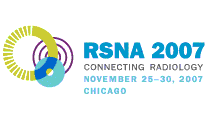
Abstract Archives of the RSNA, 2007
Vishal Gupta, Presenter: Nothing to Disclose
Suzan Cheng MD, Abstract Co-Author: Nothing to Disclose
Srinivasan Vijayakumar MD, Abstract Co-Author: Nothing to Disclose
James A. Purdy PhD, Abstract Co-Author: Nothing to Disclose
Joerg Lehmann PhD, Abstract Co-Author: Nothing to Disclose
To analyze changes in the bladder volume at the time of treatment during a course of IMRT for carcinoma of the prostate using kilovoltage (kV) cone beam computed tomography (CBCT).
Five prostate cancer patients (4 intact prostates, 1 post-prostatectomy) undergoing image-guided IMRT were selected for this study. Planning CTs were performed for each patient. Patients were instructed to consume 16 ounces of water prior to their treatment planning scan and daily treatments. For each patient, a daily pre-treatment kV CBCT was acquired and registration with the planning CT performed to reduce patient setup variations. Ten kV CBCT scans for each patient (50 scans total) were selected (every other day for the first four weeks) and exported (via DICOM) to a treatment planning system for analysis. Bladder volumes were contoured slice-by-slice for each CBCT study by a single physician. Contours were checked by another physician. The relative differences between the bladder volume at time of treatment (as determined using CBCT) compared to the planning CT were calculated for all instances. Trends of this measure within the treatment of each patient were analyzed as well as, mean, median, range, standard deviation for each single patient and for the group.
The median bladder volume for a patient at the time of treatment was on average 51% lower than the bladder volume in the planning CT. The range of bladder volumes varied significantly between the patients. For a single patient, the smallest range was 86 ml (58 - 143 ml), while the largest range was 313 ml (149 - 463 ml). For most patients there did not appear to be a relationship between bladder volume and fraction number. The post-prostatectomy patientís range did not differ significantly from the patients with an intact prostate.
Bladder volumes at the time of treatment changed significantly during a course of prostate IMRT despite specific patient instructions regarding bladder filling. This underlines the importance of daily image guidance in the setup of prostate cancer patients. In addition, these daily variations likely affect dose to the bladder and prostate, which may influence toxicity and outcomes. Thus, this study supports accelerated development of adaptive radiation therapy techniques for the treatment of prostate cancer.
Gupta, V,
Cheng, S,
Vijayakumar, S,
Purdy, J,
Lehmann, J,
Inter-Fraction Variation in Bladder Volumes Assessed by Cone Beam CT Imaging for Patients Undergoing Image-guided Radiation Therapy for Prostate Cancer. Radiological Society of North America 2007 Scientific Assembly and Annual Meeting, November 25 - November 30, 2007 ,Chicago IL.
http://archive.rsna.org/2007/6001002.html


 Trainee Research Prize - Resident
Trainee Research Prize - Resident